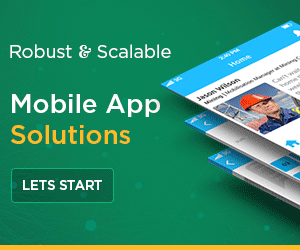
The business processes are driven by the need for collaboration and coordination within the key component of businesses, which also confirms the execution, management, and modeling of the processes. Business Intelligence is an integral tool of decision making where most of the business problems include the spatial components. The decision taken over the predictive analysis highly demands the location-based inputs because the generic solutions are more like the un-targeted arrows in the dark. The decision-makers are today leveraging the spatial data resources for core tools designed to extract and analyze the data such as customer relationship management, supply chain management, and enterprise resource planning.
Playing with data, it delivers no results. Without the proper integration, display, and analysis you might end up with an enormous amount of data but no information. An Enterprise GIS app development integrates and weaves together the disparate business functions within organizational boundaries, which ultimately depends on the spatial relationships.
What is GIS?
Come back to the ground level question. As per the definition, the geographic information system is the powerful decision making and business intelligence tool for businesses and industry that delivers real-time and location-based insights. The tools allow the analysis of environmental, demographic, and topographic data where the integration with data intelligence helps industries and consumers to make informed decisions. The location-based information is the tool for better operational intelligence and real-time awareness. The decision makers strive to boost revenue and set the strategic direction for the companies where the GIS provides insight into the sales trends, opportunities, and probable threats.
Benefits of GIS
The Geographic information system is helping the business executives for targeting higher goals across the industry verticals. The manufacturers are using GIS and Spatial Analytics for spotting the customer preferences and spending the budget efficiently whereas insurers are getting help to price the risk more effectively. The entry of commercial off the shelf solutions for information management was addressed against the demand for the development and maintenance of custom software. The commercial off the shelf solutions are tailor-made for closely matching the existing business requirement, processes, and associated tools.
The development of custom software for integration with the existing tools is the time and money consuming option. Therefore, it is necessary to make adjustment and tweaks in the existing tool to improve efficiency. These ways, it becomes easier to develop the workflow and implement the best practices to provide information whenever needed by the users and additional efficiencies. Practically, the businesses devise to modify the current business processes in accordance with the custom solutions. The successful GIS integration ultimately depends on the participation of the management team.
Real world examples of GIS integration:
Organizations incorporate the geographical data into the planning and maintenance activities for generating better information and empowering the customer relationship management.
Banking is the entire market drive approach where success strictly depends on customer satisfaction. GIS plays an important role in planning, organizing, and decision-making.
GIS applications help in gathering weather data, which is helpful in conserving natural resources.
The efficient GIS system helps in protecting the environment and predicts the risks, whereas the geolocation-based information always works tremendously when integrated with the tools.
The benefits of GIS:
Location based app development is oriented to analyze the data in the context of time and geography, which is leveraged by decision makers to visualize the information. Many companies are pushing GIS into the new business realms along with core business problems for making informed decisions.
Here are the ways GIS can be used in everyday life:
1. Google Maps: When it comes to finding the navigation across the map, Google Map stands at the first choice. The tool by Google is used on a daily basis by almost everyone for daily navigation, finding the best route, searching for nearby restaurants and many more general tasks.
2. Advanced Networking Services: Incorporating the geographical data into complex network designs and maintenance activities result in better customer satisfaction.
3. Urban Planning: GIS data can better be used in perceiving what human eyes can’t. For constructing the infrastructure, road development, urban expansion, rail route set up the GIS offers a more detailed approach to work upon.
4. Agriculture and Natural resource management:
- The power of GIS can be leveraged for efficient farming techniques, increase food production, and soil analyzing. Through GIS, the water reservoirs can also be preserved along with the adequate management of forest land.
- Water Irrigation management: GIS eases out the task of identifying the water-rich regions and the level of underground water resources. This helps in taking right decision for crop management and involving efficient techniques.
5. Disaster Management and Damage estimation: For the remote areas, natural calamities are hard to cope up with. A GIS helps in assessing the risks for disaster management and map the flood risk areas, land erosion impacts, and other mishaps.
6. Financial Transactions:
- Banking services are directly dependent over the up and downs of the market and the success of the banking system is affected by customer satisfaction. A proper planning and decision-making effort can bridge the gaps between the financial decisions and market flow, which is possible with the help of Geolocation based mapping and planning.
- Taxation: Geographical mapping helps in determining the tax and levy slabs for infrastructures and engineering developments. This maximizes the government revenue by demarcating the block areas for a certain tax slab.
7. Utility management:
The collaboration of GIS, IoT, and SCADA is viable too for auto improval of the systems. In power distribution systems, the information of GIS is amalgamated with the Supervisory Control and Data Acquisition system that entrusts the maximum performance by enabling the utility managers to visually monitor critical factors. The operational intelligence with the real-time view drives towards better decisions.
8. Asset tracking: For the companies dealing with the hardware or working in a manufacturing business, it is crucial to keep track of supply chain management. Here, the GIS assists with real-time intelligence for the assets in motion for better deliveries. The time-based delivery and fuel-saving is also possible with the GIs, where it prescribes the route for the driver, and increases driver safety.
9. Block-level insights for investors:
GIS supports the core business activities and helps in maximizing the individual store performance by assisting in site selection. The site selection prior-hand results in minimizing the competition and gain confidence for the business decisions. The mapped data allows companies to know where potential customers are and make strategic decisions.
Verdict
The use of GIS makes a profound impact over the industry, however, merging the company’s databases with sophisticated GIS hardware help businesses had better visualize the relationship between customers and suppliers while augmenting the profit margins. The investment in GIS leads to a significant decrease in expenditure and an increase in the firm’s business plan. Every new tool demands a little adjustment with integration and learning curve to let users make optimum use of the information. Over the coming decade, GIS, SCADA, IOT, CIS, LIMS, and network models will integrate with the machine learning tools for providing the state of the art information system. We anticipate the great growth in ML over the coming decade, which would surely make the impressive growth map for businesses.



